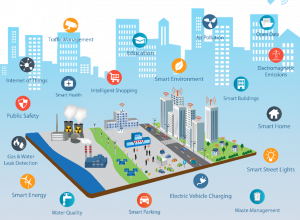This post is also available in: Català (Catalan) Español (Spanish)
 In the previous @altradio session at @radio4_rne we explored the reasons for a municipality to deploy an open commons IoT network (#IoT) for its own use.
In the previous @altradio session at @radio4_rne we explored the reasons for a municipality to deploy an open commons IoT network (#IoT) for its own use.
Besides avoiding being tied to a provider, the investment results in a public infrastructure that is made available to everyone for any use, as long as their setup supports low transmission speeds. The network would not support Internet connectivity or video surveillance, nor do we recommend it for critical services, but it is a very good solution for many other uses.
People at XOIC are introducing some uses for a LoRaWAN-TTN (@ttncat) network:
- Community organizations can take the initiative to monitor their immediate surroundings and environmental pollution (air, noise, light, etc.) in addition to other parameters of their digital twin.
- Forest agents can use the infrastructure to monitor the state of forests, detect wildfires through autonomous sensors powered by solar panels that can be hung from trees, know the number of visitors, as well as monitor the raft level and other remote resources.
- Irrigation communities can use the network to control and measure the consumption of water, electricity and other resources on farms. It can also be used to track cattle and deploy digital fences, allowing them to remove physical fences and improve the landscape.
- Individuals can install sensors to report comfort data from their house anonymously, and also monitor gas detectors, water leaks, etc. without depending on electricity or Internet connectivity at home. Actuators can also be used to control light switches, heating or water pumps. This use is of special interest for farmhouses or vacation houses that can use autonomous sensors such as intrusion alarms or leak detectors.
- Companies can use these networks to track vehicle fleets because they are global and open. They can also be used to ensure a cold chain and to detect if a parcel has suffered damage during transport.
- Gyms, cinemas, theaters and other buildings with public attendance can use autonomous mobile equipment to study specific parameters such as vibration, noise, temperature and concentrations of different gases in different areas at different times in a very unobtrusive way. Since this technology is designed for low connectivity and low speed, it allows autonomous equipment without cables.
- Construction companies can use robust versions of these sensors to track vibrations, noises or tilts that are potentially dangerous using autonomous equipment that can be moved from place to place freely without headaches caused by reconfigurations or reconnections.
- The network can also be used as a learning platform for students, and as a testbed for developers to validate IoT services and prototypes at a very low cost.
It is worth stressing out that the network is open to everyone and free to use. It is anonymous for its users and secure for data. This means that anyone can use it for any purpose with any compatible product
In short, we propose a technological solution for municipal IoT needs, while deploying a public infrastructure accessible to everyone anonymously.
With increased use, robustness and reach of the network also grows. Individuals, collectives and companies can strengthen and extend the network by installing new infrastructure. This new infrastructure is also public and benefits all users: more antennas installed in different locations result in increased coverage and redundancy.
A community of users like this one will bring new personal and professional connections, transfer of knowledge, collaboration in new projects, mutual support, etcetera.
We encourage you to join the project and make use of the network!
You can listen to our intervention at minute 21:49 of the @altraradio from @radio4_rne podcast from 17/5 at https://t.co/6L1wnjHc2C or check at Twitter.
